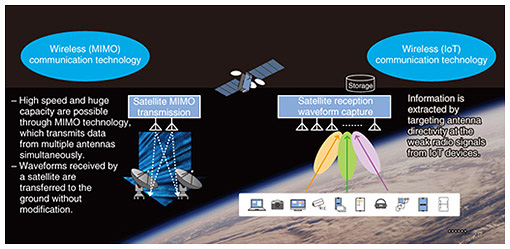 |
|||||||||||||||||||
|
|
|||||||||||||||||||
|
Feature Articles: Space Integrated Computing Network Vol. 20, No. 12, pp. 17–22, Dec. 2022. https://doi.org/10.53829/ntr202212fa1 Overview of Space Integrated Computing NetworkAbstractThere is an urgent need to ensure the sustainability of social activity. This makes it all the more important to use space for information and communication technology (ICT) infrastructures. This involves creating ICT infrastructures that support a number of fields, including energy, environment, and disaster prevention. To this end, NTT and SKY Perfect JSAT have established a joint venture company, Space Compass Corporation, that will launch a novel space ICT infrastructure, the Space Integrated Computing Network. This article gives an overview, business outline, and future prospects of this network. Keywords: space, computing, network 1. Challenge for new space infrastructuresThere is an urgent need to ensure the sustainability of economic and social activity. This makes it all the more important to effectively and fully use stratospheric and near-Earth space for information and communication technology (ICT) infrastructures. This involves creating ICT infrastructures that support a number of fields, including energy, environment and climate change, disaster prevention, marine infrastructure, and security. Novel technologies and architectures are needed to build these ICT infrastructures in outer space. NTT and SKY Perfect JSAT established a joint venture company, Space Compass Corporation, on July 20, 2022 to expand the utilization of space by humankind, building on the knowledge they have gained over many years spent on technological development and in commercial activity as terrestrial and space infrastructure companies [1, 2]. The establishment of the joint venture is a step toward building the Space Integrated Computing Network announced in the 2021 collaboration agreement [3]. By taking on the challenge of creating new infrastructures, starting with the optical and wireless communication network to be built in space and the mobile network to be built in the stratosphere, the joint venture will contribute to the development of the global space industry and actualization of a sustainable society. 2. Space Integrated Computing NetworkThe Space Integrated Computing Network is a novel infrastructure to be built by combining NTT’s network/computing infrastructure and SKY Perfect JSAT’s space assets/business (Fig. 1). It will integrate multiple orbits from the ground to high altitude platform stations (HAPSs) flying at high altitude, low Earth orbit (LEO) satellites, and geostationary orbit (GEO) satellites. They will be connected to the ground through an optical wireless communication network to form a constellation to enhance various data processing by distributed computing. It will also provide access to terrestrial mobile devices for ultra-wide service coverage.
3. Outline of planned business projectsThe following is a summary of the business activities to be undertaken toward the actualization of the Space Integrated Computing Network. (1) Space datacenter project: high-capacity communication and computing infrastructure in space Using photonics-electronics convergence technology, which reduces power consumption, and high cosmic ray resistance of computing resources, we will establish a computing processing platform in outer space and launch a service using this platform (Fig. 2). Distributed computing using high-capacity optical communication technology will enable a variety of advanced data processing. For example, a huge volume of diverse data collected in outer space will be instantly gathered and analyzed over a high-speed optical communication network, and only essential information will be delivered to users who need that information. This will dramatically enhance both real-time usage of space data and user convenience.
In FY2024, Space Compass will launch an optical data relay service (Fig. 3) for high-speed transmission to the ground via a GEO satellite as its initial business activity. This will carry a vast amount of diverse data collected in space by Earth observation satellites. Current services, which transmit data directly to ground stations, have communication-capacity limits imposed by the use of radio waves as well as limits on the time at which ground stations can communicate with observation satellites. In contrast, optical transmission via a GEO satellite will enable high-capacity, quasi-real-time data transmission. The communication speed is about 10 times faster than current services, and data can be transmitted immediately at any given time. The use of optical wireless communications has the advantage of eliminating the need for licensing adjustments required for conventional wireless communication services. For Earth observation satellite operators as customers, there is the advantage of improved observation satellite capabilities and increased operational efficiency.
(2) Space radio access network (Space RAN) project: communication infrastructure for Beyond 5G/6G Using satellites (LEO, GEO) and HAPS [4, 5] expected to be used for Beyond fifth-generation mobile communication network (5G)/6G, we will establish a mobile communication platform and use it to launch an access network service (Fig. 4). This will further enhance the convenience and value of mobile communication. For example, a highly reliable messaging service can be provided, and ultra-wide-area service coverage can be achieved.
Space Compass will use HAPSs to provide low-latency communication services in Japan in FY2025 as its initial business activity. HAPSs make it easy to expand communication-service coverage to a wider area. Thus, it is possible to provide highly reliable communication in times of disaster, high-capacity communication for ships and aircraft, and communications services for distant islands and remote areas. Mobile carriers can improve the overall cost-effectiveness and energy efficiency of their mobile networks by combining HAPSs with an increase in the number of their terrestrial base stations to expand their service coverage. HAPSs will enable end users to better communicate via smartphones for everyday use in distant islands and remote areas. (3) Space sensing project: terrestrial and space sensing data integration infrastructure In addition to observation data captured by conventional observation satellites, we will establish an integrated space and Earth sensing infrastructure that uses the world’s first LEO satellite multiple-input and multiple-output (MIMO)* technology to collect data from Internet of Things (IoT) terminals installed around the Earth and provide a service using this infrastructure (Fig. 5). This technology is scheduled to be demonstrated in orbit by the Japan Aerospace Exploration Agency (JAXA)’s Innovative Satellite Technology Demonstration No. 3, which is scheduled for launch in 2022. We will also develop a sensing technology that uses terahertz radio waves to visualize information that would ordinarily be invisible, thereby enhancing the value of space data and expanding its potential use.
4. Research and development for commercializationThere are various technical issues to be addressed for the commercialization of the Space Integrated Computing Network. The Feature Articles in this issue introduce the main technologies that have been researched and developed to address these issues, including technology overviews, use cases, and value to be provided. (1) Event-driven inference for space computing: An overview of computing technology for edge processing of a huge volume of data in space by distributed computing to improve real-time performance and user convenience of space data utilization [6]. (2) Efforts toward commercialization of HAPS in Space RAN: An overview of use cases of HAPS, and configuration and control technologies of HAPS and terrestrial coordination network for providing super coverage, high reliability, and low-latency communication services [7]. (3) Satellite sensing platform: An overview of satellite sensing technology that extracts weak radio waves from inexpensive IoT terminals by targeting antenna directivity, and high-capacity transmission technology that transmits received satellite waveform data directly to the ground, as well as in-orbit demonstrations, to provide ultra-coverage and low-cost sensing [8]. 5. Future prospectsSpace Compass will start the two businesses/services mentioned above as the first step in the Space Integrated Computing Network initiative then gradually strengthen them. For the space datacenter, the company will steadily increase the number of satellites equipped with advanced computing functions to build a high-capacity communication/computing processing infrastructure in space. The company will also demonstrate NTT’s high-capacity optical communication technology in space at Expo 2025 Osaka, Kansai, Japan and plans to deploy its services globally thereafter. For Space RAN, Space Compass plans to study the provision of image sensing using HAPSs. The company will also add and integrate GEO and LEO satellites to expand service-area coverage and increase the communication capacity per HAPS by developing radio communication band broadening technology. References
|
|||||||||||||||||||
















